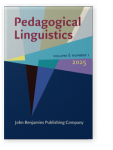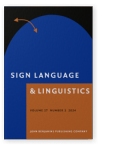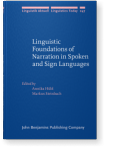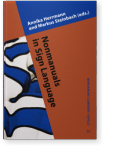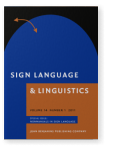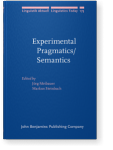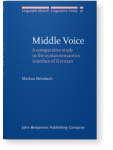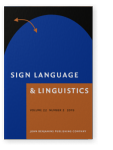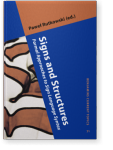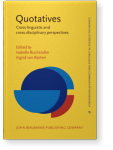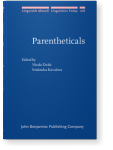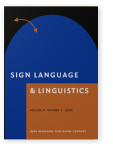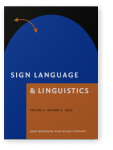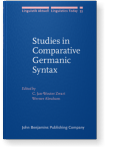Markus Steinbach
List of John Benjamins publications for which Markus Steinbach plays a role.
Journals
ISSN 1387-9316 | E-ISSN 1569-996X
Linguistic Foundations of Narration in Spoken and Sign Languages
Edited by Annika Hübl and Markus Steinbach
[Linguistik Aktuell/Linguistics Today, 247] 2018. xii, 311 pp.
Subjects Discourse studies | Narrative Studies | Pragmatics | Psycholinguistics | Signed languages | Theoretical linguistics
Nonmanuals in Sign Language
Edited by Annika Herrmann and Markus Steinbach
[Benjamins Current Topics, 53] 2013. v, 197 pp.
Subjects Gesture Studies | Signed languages | Theoretical linguistics
Nonmanuals in Sign Language
Edited by Annika Herrmann and Markus Steinbach
Special issue of Sign Language & Linguistics 14:1 (2011) vi, 212 pp.
Subjects Electronic/Multimedia Products | Signed languages | Theoretical linguistics
Experimental Pragmatics/Semantics
Edited by Jörg Meibauer and Markus Steinbach
[Linguistik Aktuell/Linguistics Today, 175] 2011. x, 240 pp.
Subjects Pragmatics | Semantics | Theoretical linguistics
Middle Voice: A comparative study in the syntax-semantics interface of German
Markus Steinbach
[Linguistik Aktuell/Linguistics Today, 50] 2002. xii, 337 pp.
Subjects Generative linguistics | Germanic linguistics | Semantics | Syntax
2023 Neurophysiological evidence for the first mention effect during pronominal reference resolution in German Sign Language Sign Language & Linguistics 26:1, pp. 117–138 | Squib
Anaphoric pronoun resolution in spoken language has been shown to be influenced by the first mention bias. While this bias has been well investigated in spoken languages, less is known about a similar bias in sign languages. In sign languages, pronominal pointing signs (index) are directed… read more
2022 Gehen as a new auxiliary in German Language Change at the Interfaces: Intrasentential and intersentential phenomena, Catasso, Nicholas, Marco Coniglio and Chiara De Bastiani (eds.), pp. 165–188 | Chapter
This paper aims to investigate the so-called gehen+infinitive construction in German, in which an inflected form of the (movement) verb gehen ‘go’ is combined with the infinitive of another main verb and, thus, seems to behave like an auxiliary syntactically. Supported by two questionnaire… read more
2021 Phonological priming in German Sign Language: An eye tracking study using the Visual World Paradigm Sign Language & Linguistics 24:1, pp. 4–35 | Article
A number of studies provide evidence for a phonological priming effect in the recognition of single signs based on phonological parameters and that the specific phonological parameters modulated in the priming effect can influence the robustness of this effect. This eye tracking study on German… read more
2019 To shift or not to shift: Indexical attraction in role shift in German Sign Language Sign Language & Linguistics 22:2, pp. 171–209 | Article
There are two main competing views about the nature of sign language role shift within formal semantics today: Quer (2005) and Schlenker (2017a,b), following now standard analyses of indexical shift in spoken languages, analyze it as a so-called ‘monstrous operator’, while Davidson (2015) and… read more
2018 Approaching narration across modalities: Topics, methods, perspectives Linguistic Foundations of Narration in Spoken and Sign Languages, Hübl, Annika and Markus Steinbach (eds.), pp. 1–14 | Chapter
2015 PERSON climbing up a tree: (and other adventures in sign language grammaticalization) Signs and Structures: Formal Approaches to Sign Language Syntax, Rutkowski, Paweł (ed.), pp. 71–101 | Article
Studies on sign language grammaticalization have demonstrated that most of the attested diachronic changes from lexical to functional elements parallel those previously described for spoken languages. To date, most of these studies are either descriptive in nature or embedded within… read more
2013 Nonmanuals in sign languages Nonmanuals in Sign Language, Herrmann, Annika and Markus Steinbach (eds.), pp. 1–6 | Article
2013 person climbing up a tree: (and other adventures in sign language grammaticalization) Sign Language Syntax from a Formal Perspective: Selected Papers from the 2012 Warsaw FEAST, Rutkowski, Paweł (ed.), pp. 189–220 | Article
Studies on sign language grammaticalization have demonstrated that most of the attested diachronic changes from lexical to functional elements parallel those previously described for spoken languages. To date, most of these studies are either descriptive in nature or embedded within… read more
2012 Quotation in sign languages: A visible context shift Quotatives: Cross-linguistic and cross-disciplinary perspectives, Buchstaller, Isabelle and Ingrid van Alphen (eds.), pp. 203–228 | Article
Assuming that quoting utterances and thoughts is a universal property of natural languages, sign languages are also expected to have various linguistic means to mark quotation. Like spoken languages, sign languages have regular forms of indirect reported speech. However, sign languages mostly draw… read more
2011 Nonmanuals in sign languages Nonmanuals in Sign Language, Herrmann, Annika and Markus Steinbach (eds.), pp. 3–8 | Article
2011 Introduction: Experimental research at the pragmatics/semantics interface Experimental Pragmatics/Semantics, Meibauer, Jörg and Markus Steinbach (eds.), pp. 1–18 | Article
Focusing on the semantics/pragmatics divide, the contribution of experimental pragmatics to pragmatic theory is discussed from a number of angles, ranging from implicature theory and theories of pragmatic enrichment to pragmatic acquisition, pragmatic impairment, and pragmatic processing. In… read more
2008 Review of Sandler & Lillo-Martin (2006): Sign language and linguistic universals Sign Language & Linguistics 11:1, pp. 108–111 | Review
2007 Integrated parentheticals and assertional complements Parentheticals, Dehé, Nicole and Yordanka Kavalova (eds.), pp. 53–87 | Article
German has three different kinds of verb-first integrated parentheticals (VIPs), which differ from other kinds of parentheticals in several respects: (i) VIPs have verb-first order; (ii) they form one focus-background-structure with their host; (iii) the proposition expressed by the host is linked… read more
2003 Optimal reciprocals in German Sign Language Sign Language & Linguistics 6:1, pp. 3–42 | Article
Unlike most spoken languages, German Sign Language (DGS) does not have a single means of reciprocal marking. Rather, different strategies are used, which crucially depend on phonological (one-handed sign vs. two-handed sign) and morphosyntactic (plain verb vs. agreement verb) properties of the… read more
2002 Review of Erlenkamp (2000): Syntaktische Kategorien und lexikalische Klassen Sign Language & Linguistics 5:2, pp. 247–253 | Review
2002 The ambiguity of weak reflexive pronouns in English and German Studies in Comparative Germanic Syntax: Proceedings from the 15th Workshop on Comparative Germanic Syntax (Groningen, May 26–27, 2000), Zwart, Jan-Wouter and Werner Abraham (eds.), pp. 317–342 | Article
